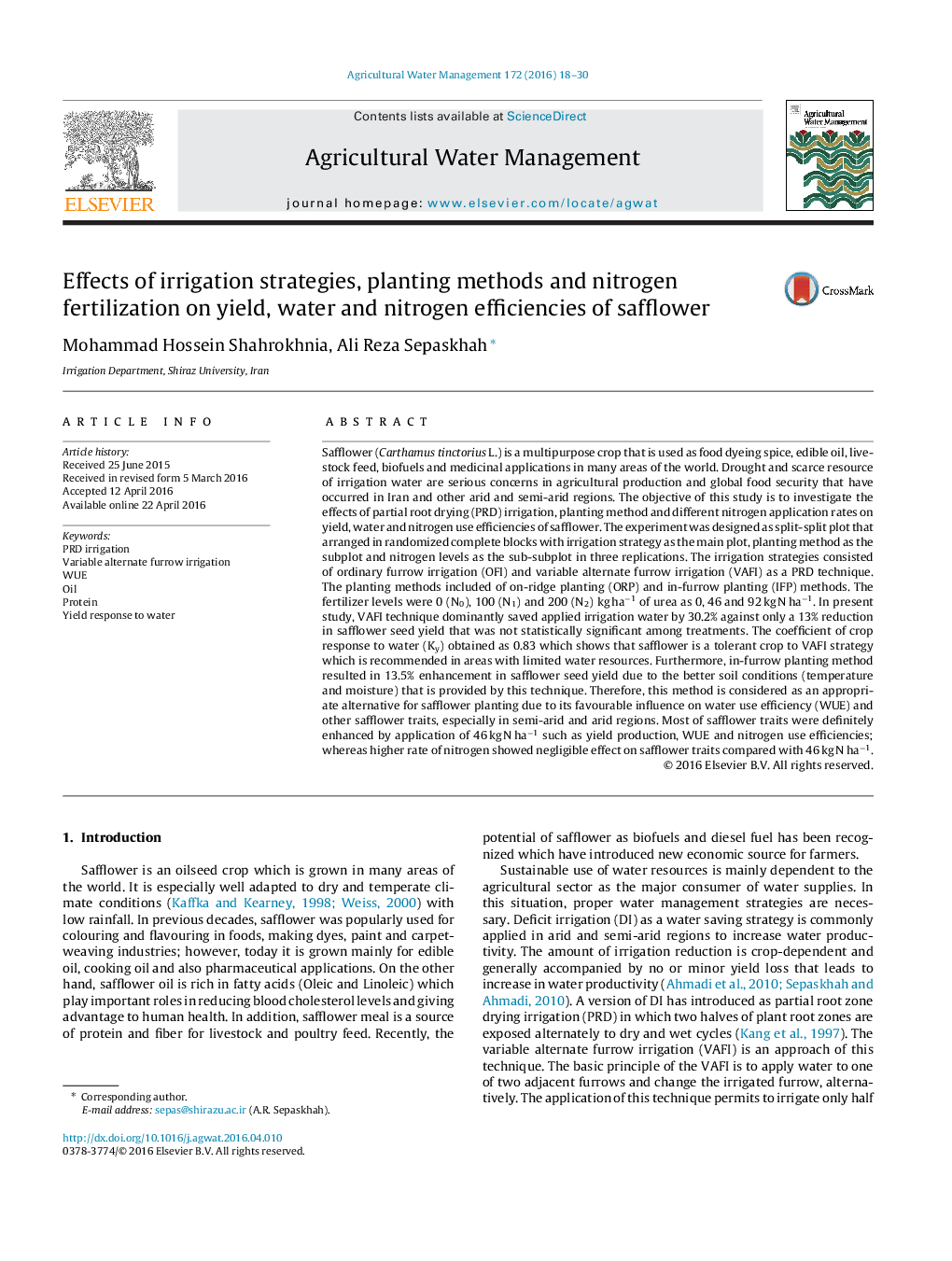| کد مقاله | کد نشریه | سال انتشار | مقاله انگلیسی | نسخه تمام متن |
|---|---|---|---|---|
| 6363506 | 1622908 | 2016 | 13 صفحه PDF | دانلود رایگان |
عنوان انگلیسی مقاله ISI
Effects of irrigation strategies, planting methods and nitrogen fertilization on yield, water and nitrogen efficiencies of safflower
ترجمه فارسی عنوان
تأثیر استراتژی های آبیاری، روش های کاشت و باروری نیتروژن بر عملکرد، عملکرد آب و نیتروژن گلرنگ
دانلود مقاله + سفارش ترجمه
دانلود مقاله ISI انگلیسی
رایگان برای ایرانیان
کلمات کلیدی
موضوعات مرتبط
علوم زیستی و بیوفناوری
علوم کشاورزی و بیولوژیک
علوم زراعت و اصلاح نباتات
چکیده انگلیسی
Safflower (Carthamus tinctorius L.) is a multipurpose crop that is used as food dyeing spice, edible oil, livestock feed, biofuels and medicinal applications in many areas of the world. Drought and scarce resource of irrigation water are serious concerns in agricultural production and global food security that have occurred in Iran and other arid and semi-arid regions. The objective of this study is to investigate the effects of partial root drying (PRD) irrigation, planting method and different nitrogen application rates on yield, water and nitrogen use efficiencies of safflower. The experiment was designed as split-split plot that arranged in randomized complete blocks with irrigation strategy as the main plot, planting method as the subplot and nitrogen levels as the sub-subplot in three replications. The irrigation strategies consisted of ordinary furrow irrigation (OFI) and variable alternate furrow irrigation (VAFI) as a PRD technique. The planting methods included of on-ridge planting (ORP) and in-furrow planting (IFP) methods. The fertilizer levels were 0 (N0), 100 (N1) and 200 (N2) kg haâ1 of urea as 0, 46 and 92 kg N haâ1. In present study, VAFI technique dominantly saved applied irrigation water by 30.2% against only a 13% reduction in safflower seed yield that was not statistically significant among treatments. The coefficient of crop response to water (Ky) obtained as 0.83 which shows that safflower is a tolerant crop to VAFI strategy which is recommended in areas with limited water resources. Furthermore, in-furrow planting method resulted in 13.5% enhancement in safflower seed yield due to the better soil conditions (temperature and moisture) that is provided by this technique. Therefore, this method is considered as an appropriate alternative for safflower planting due to its favourable influence on water use efficiency (WUE) and other safflower traits, especially in semi-arid and arid regions. Most of safflower traits were definitely enhanced by application of 46 kg N haâ1 such as yield production, WUE and nitrogen use efficiencies; whereas higher rate of nitrogen showed negligible effect on safflower traits compared with 46 kg N haâ1.
ناشر
Database: Elsevier - ScienceDirect (ساینس دایرکت)
Journal: Agricultural Water Management - Volume 172, 1 July 2016, Pages 18-30
Journal: Agricultural Water Management - Volume 172, 1 July 2016, Pages 18-30
نویسندگان
Mohammad Hossein Shahrokhnia, Ali Reza Sepaskhah,
